Transfer the heated towel rail to another wall in the bathroom: installation instructions
When repairing the bathroom, you may need to transfer the heated towel rail to another wall with a change in the location of the water pipes. The complexity of the work performed depends on the type of coil.
If you do not need special skills to transfer the electric unit, then when you connect a heated towel rail, you may need the help of a plumber.
We will understand what is the sequence of actions in a given situation, and also designate the rules for placing and installing different types of coils.
The content of the article:
Features of mounting an electric model
If the owners of private houses independently choose where to place this element, then residents of apartment buildings are often deprived of a choice, since in their apartments appliances are placed in bathrooms according to the original plan.
Often places for heated towel rails are chosen very uncomfortable, for example, above the sink. In this case, at the first repair or redevelopment, the landlord will be asked to transfer the device to a more comfortable place. But how to do it by all the rules, with the least damage to the bathroom and without unpleasant consequences?
Carrying an electric heated towel rail does not cause any difficulties - it happens much easier than in the case of analogues of the water type. It is also not required to coordinate the transfer of the electric model with documents, since in this case no types of communications will be affected.
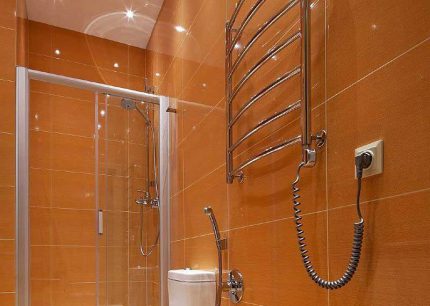
An electric heated towel rail is considered more practical than water, not only because of the ease of installation, but also due to ease of use.
The advantages of electric dryers:
- Year-round operation. The closed circuit of electric dryers allows you to operate them all year round, even when the heating system is turned off or hot water is not supplied due to preventive maintenance.
- Wear resistance. Electric appliances are not afraid of pressure drops, hard water and corrosion.
- Ability to adjust the heating temperature. To do this, you only need to additionally install a rheostat, in some models it is present initially.
That is why many owners for the arrangement of the bathroom prefer electric to water heated towel rails.
Different are represented on the market types of electric heated towel rails - distinguish between dry and oil models. In liquid, tubular electric heaters are usually used.

In order to ensure the normal safe operation of electric dryers, you need to adhere to several rules:
- wiring must be qualitatively hidden in the wall;
- it is advisable to install a residual current device on the wiring to the bathroom, ideally on the heated towel rail itself;
- ground the device, as it is located in a room with high humidity;
The outlet for the device, like any outlet in the bathroom, must also be grounded and have degree of protection IP4 or IP65 (from dust or direct jets of water and dust).
Instructions for moving the appliance
After we have considered all the nuances, we can proceed directly to transferring the heated towel rail to the bathroom or toilet.
To work, we need the following tools:
- hammer drill or hammer drill;
- concrete drills;
- Screwdriver Set;
- set of wrenches;
- electrical tester;
- tape measure, marker;
- mounting brackets on the wall.
First of all, decide on the place where the dryer will be located.
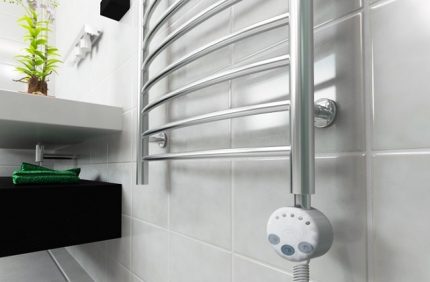
If there is a power source near the selected location, the whole process will be as simple as possible. If there is none, the task will become more complicated, since it will be necessary to lay a separate wire. This can be done in two ways: under the lining or on it.
If you make repairs in the bathroom and change the cover, feel free to use the first option - although it is more time-consuming, it provides reliable wiring shelter.
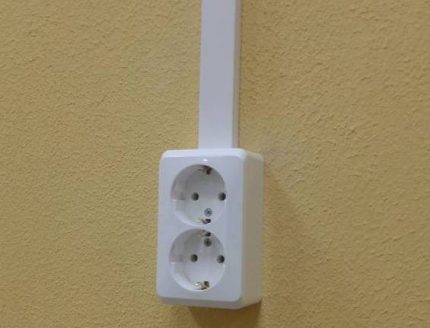
Then we dismantle the device from the old place. This work, as a rule, does not cause difficulties. First we remove the device, then with the help of screwdrivers we remove the fasteners.
The next step is to install and electric drying connection. On the wall, prepare the holes for the fasteners and install the holders. Next - we fix the brackets and mount the device on them. At the end we make finishing work.
If the cable was laid on the cladding, no additional finishing is required.
How to outweigh a water heated towel rail?
Carrying a water-type heated towel rail is a much more time-consuming process than with the electric version. But, having the skills and the necessary tools, you can transfer the water device to another wall yourself.
Design and connection methods
Water-type towel dryers have the following design features:
- air bleed valve - the Mayevsky crane is located on top;
- special plug - plug;
- water supply system;
- valves for shutting off water - in some models are mounted in the device itself, more often are installed separately;
- brackets for fixing and hanging on the wall.
The water heated towel rail can operate from a heating system or from a hot water system.
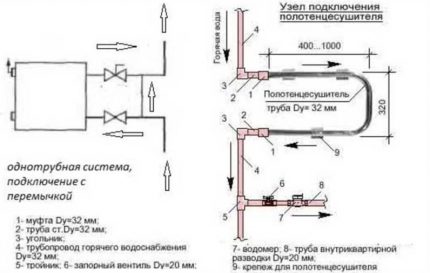
It is preferable to mount the radiator by tapping into a hot water supply system, there are several reasons for this:
- The heating system works a little more than half a year, the remaining 5-6 months the batteries are not provided with heat and, accordingly, do not fulfill their main functions.
- In case of leakage of the coil and other breakdowns, the hot water supply system is very easy to shut off, which cannot be said about the heating system, which is very problematic to shut off.
- The water supplied to the taps is much cleaner than the water in the heating systems, in addition, it manages to stagnate for several months of the heating season, which significantly increases the risk of corrosion.
Before starting work, it is necessary to draw up a documentary agreement with the housing and operating authorities. Independently moving any heating devices, including a heated towel rail, leads to a change in the technical parameters and condition of the heating system.
In case of problems, the responsibility lies with the owner of the house, so it is very important to agree on any changes at the documentary level in advance.
There is one more nuance - for work you will need to completely turn off the water on the entire riser and drain it, and for this you need to call a specialist from the housing department.
Terms of use of the new model
At choosing a water coil it is necessary to adhere to a number of rules:
- The technical parameters of the selected model must correspond to the level water system pressure at home. Operating pressure can range from 2.5 to 7.5 atmospheres. The indicator depends on the floor, the state of communications, even the time of day - at night the pressure rises.
- The size of the device should fit the dimensions of the bathroom - the smaller the bathroom, the smaller the heated towel rail, with fewer knees, you need.
- The diameter of the outlet pipes of the device must correspond to the size of the inlets in the pipes of the riser. If the parameters do not match, you can use special jumpers.
If possible, choose a seamless heated towel rail with water hammer protection.
The following materials and tools will be required for the technical work of moving the heated towel rail:
- mounting brackets;
- polypropylene pipes;
- Bulgarian;
- welding machine;
- pipe cutter or nippers;
- wrench and adjustable spanner;
- level;
- Ball Valves;
- thread cutting machines;
- linen winding or fum tape;
- connecting fittings.
After completing the preparatory phase, we proceed to the installation work.
Rules for dismantling the heated towel rail
For dismantling, first of all, we shut off the main riser and drain the water from it. As mentioned earlier, this will require the presence of a specialist from the housing department.
Also, do not forget to warn the neighbors about turning off the water so as not to spoil the relationship once again. The process itself will take a couple of hours.

To do this, you need a grinder and an assistant. One person will cut the dryer, the other will support it, otherwise you can drop the appliance on yourself and get serious injuries. After trimming the inlet and outlet pipes, the device can be freed from the fasteners and taken out of the room.
Arranging a riser and piping
After dismantling the old heated towel rail, we proceed to work with the riser.
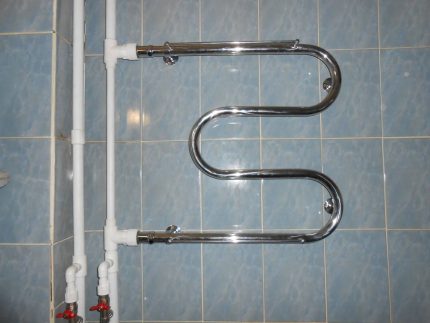
An ideal option would be to unite with neighbors and replace pipe riserand. If this is problematic, you can limit yourself only to your apartment.
Thus, you will not only facilitate the connection of a heated towel rail and other plumbing to new pipes, but also in future insure yourself against leaks, breakdowns and other troubles with outdated pipes.
Professionals advise applying polypropylene pipes with a diameter of 25 mm.
Progress:
- To lay the riser pipe to a new installation site, specialist assistance may be required, especially if the distance is large. A competent engineer will not only advise you on the correct installation of pipes, but also carry out the necessary hydraulic engineering calculations. Do not neglect the help of professionals, as an improperly installed device will not heat up and can lead to an emergency.
- We clean the places of cuts at the ends of the pipes so that there are no burrs and traces of old paint.
- We cut the thread. For this we use lerka. Pre-lubricate with oil, put on the machined edge of the pipe and begin to cut the thread by carefully turning the tool. Alternatively, you can use welding instead of a threaded connection, but this will require a welding machine and skills to work with it.
- On the finished thread, you can install "American" - a special fitting that is needed to connect the system with propylene pipes.
- To prevent water leakage, we seal all joints on threaded joints with a fum tape or, as usual, with linen winding and sealant. Choose the method of your choice.
To facilitate the maintenance of the heated towel rail, it is better to mount it on a special jumper - “bypass”, and also use Ball Valves to redirect the flow of water to the jumper.
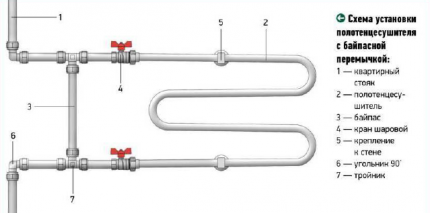
We check the system for operability, the presence of defects by starting up hot water supply. If everything suits, we fix the heated towel rail with brackets and do the finishing work.
It is advisable to deepen the pipes into the wall or hide under decorative trim. This is a rather time-consuming process, but the end result looks much more advantageous. For free access to the riser, it is recommended to make a special plastic window.
Practical tips and tricks
To carry out the transfer of a heated towel rail in the bathroom in accordance with all the rules and get a good long-lasting result, you should adhere to some rules.

For private houses with autonomous water supply, brass models that are designed for more careful operation are suitable. It is undesirable to install a heated towel rail on a wall bordering the living room.
It is not recommended to use a threaded connection in combination with a welded riser. It is also undesirable to use a threaded connection in places difficult to access for maintenance, for example, behind a decorative finish.
For correct operation of the heated towel rail, during installation, ensure a slight slope of the supply pipe towards the flow of hot water. This will help prevent air clogging.
The distance from the wall to the middle of the supply pipe should be 3.5-5.5 cm
Conclusions and useful video on the topic
A few tips from an experienced builder:
Carrying a heated towel rail in the bathroom is a rather complicated process. You need to approach him with full responsibility. If you are not confident in your abilities or do not have enough experience, it is better to contact professionals, otherwise amateur activity may result in the inoperability of the device or lead to an emergency.
If you are not a beginner in engineering, you can count on your own strength, experience and good instruction. Alternatively, you can purchase an electric model and make your life easier, but lose in terms of paying electricity bills - it all depends on personal preferences.
Share with your readers your experience of transferring and connecting a heated towel rail. Please leave comments on the article and ask your questions. The feedback form is located below.

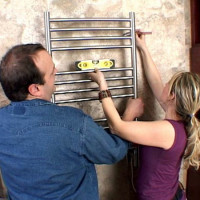 Installing a heated towel rail in the bathroom: DIY installation guide
Installing a heated towel rail in the bathroom: DIY installation guide 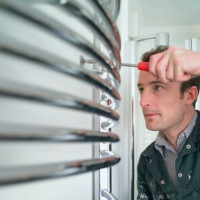 How to replace a heated towel rail in a bathroom according to the rules
How to replace a heated towel rail in a bathroom according to the rules 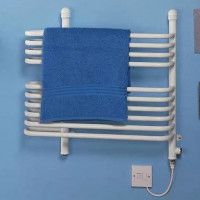 Connecting an electric heated towel rail: step-by-step installation instructions
Connecting an electric heated towel rail: step-by-step installation instructions 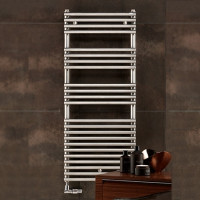 How to choose a heated towel rail for the bathroom: what to look at before buying + an overview of popular brands
How to choose a heated towel rail for the bathroom: what to look at before buying + an overview of popular brands 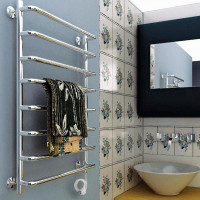 Repairing an electric heated towel rail: an overview of popular breakdowns and how to fix them
Repairing an electric heated towel rail: an overview of popular breakdowns and how to fix them 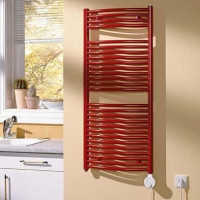 How to choose an electric heated towel rail for the bathroom: selection tips and best options
How to choose an electric heated towel rail for the bathroom: selection tips and best options  How much does it cost to connect gas to a private house: the price of organizing gas supply
How much does it cost to connect gas to a private house: the price of organizing gas supply  The best washing machines with dryer: model rating and customer tips
The best washing machines with dryer: model rating and customer tips  What is the color temperature of light and the nuances of choosing the temperature of the lamps to suit your needs
What is the color temperature of light and the nuances of choosing the temperature of the lamps to suit your needs  Replacement of a geyser in an apartment: replacement paperwork + basic norms and requirements
Replacement of a geyser in an apartment: replacement paperwork + basic norms and requirements
Honestly, after reading the question arose, who will hang a heated towel rail over the sink ?! Well, this is initially understandable, which is inconvenient. And when you wash, it will interfere with you, in addition, often in the layout of the bathrooms wash basin at a decent distance from the bath. At our place a zigzag heated towel rail that is just opposite the shower, and you can get it right there.But for those who still made mistakes when installing this equipment, it will be useful to read this material.
If the height of the ceilings allows, then you can also hang a heated towel rail above the sink, in addition, there are double sinks, for example. In such cases, the heated towel rail is not mounted directly above the sink, of course, but as close as possible to it, the mirror above the sink is more important.
Ideally, if the heated towel rail is at the same distance from the sink and shower (bath) - it is practical and convenient.
If you are connected, as advised, to the hot water supply, how many cubes per month will pass through this heated towel rail? But all of them have meters, something I’m not at all happy with the prospect of paying several thousand every month for a hot heated towel rail. And besides, in the summer, in the heat, it is completely redundant, and at other times of the year you can also ask locksmiths to turn it on. As a rule, do not refuse.
As a general rule, a heated towel rail is connected to the heating system, and not to the supply of hot water. Accordingly, you do not have to pay a meter for this water.
The question is interesting, but in practice no one checked, I do not think that someone in their right mind will connect a heated towel rail to hot centralized water. This equipment is connected to the heating system and does not affect the cost of heating the apartment! If you connect the PS to hot water, then in fact you will pay for everyone who eats from the riser.
Andrey, turn on the brain.